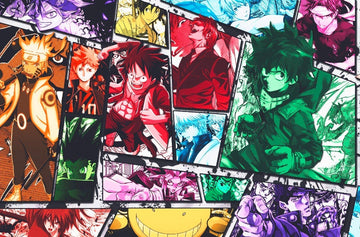Anime has become a global phenomenon that has captured the hearts and minds of fans worldwide. This unique form of animation originating from Japan has evolved over the years into a complex and multi-faceted art form encompassing a wide range of genres and styles. From its earliest beginnings to its current state, the history of anime is a fascinating and complex story that deserves to be explored.
Early History of Anime
The term anime derives from the Japanese pronunciation of "animation." The earliest examples of Japanese animation can be traced back to the early 1900s, with the work of pioneers such as Oten Shimokawa, who is considered the father of anime. Shimokawa created the first anime feature-length film, "Imokawa Mukuzo Genkanban no Maki" released in 1917. (1)
Other critical pioneers of early anime include Seitaro Kitayama, who created the first short film, "Momotaro's Divine Sea Warriors", in 1944. Osamu Tezuka, often referred to as the "Godfather of Anime", also played a significant role in the development of the medium. Tezuka created many iconic anime titles, including "Astro Boy" and "Kimba the White Lion", and introduced a more cinematic style of storytelling that had a lasting impact on the industry.
Post-WWII Era and Rise of Television
After World War II, Japan underwent a period of reconstruction and economic growth, leading to television's rise as a popular form of entertainment. This also had a significant impact on the production and consumption of anime. With the advent of television, anime studios began to produce more TV series, and anime started to gain a wider audience.
During this era, key anime titles such as "Gigantor" and "Speed Racer" became famous in Japan and other parts of the world. These shows were among the first anime series to be dubbed into English and broadcast in the United States, paving the way for the globalization of anime in the decades to come.
The 1980s and the Golden Age of Anime
The 1980s were a period of economic growth in Japan, which significantly impacted anime production. With more money invested in the industry, anime studios could experiment with new genres and storytelling techniques, leading to the emergence of a new wave of anime.
During this period, iconic anime titles such as "Dragon Ball", "Akira", and "Neon Genesis Evangelion" were produced. These shows profoundly impacted the industry and helped establish anime as a legitimate art form.
The 1990s and Beyond: The Globalization of Anime
The 1990s marked a significant turning point in the history of anime, as the rise of the internet enabled the promotion and distribution of anime to a global audience. Anime fans outside of Japan could finally access a wealth of anime content, and the popularity of anime began to spread rapidly around the world.
One of the key drivers of the globalization of anime was the establishment of the anime streaming service Crunchyroll in 2006. The service allowed fans to legally stream anime series and movies online, providing access to a massive content library. This, in turn, permitted anime to reach a wider audience than ever before.
The popularity of anime was further fueled by the rise of social media platforms like Twitter, Tumblr, and Facebook, which provided fans with a space to discuss and share their love for anime. Fan conventions, such as Comic-Con and Anime Expo, also significantly promoted anime to a broader audience.
The impact of anime on global pop culture cannot be overstated. From the iconic "Dragon Ball Z" and "Sailor Moon" to the more recent "Attack on Titan" and "Demon Slayer," anime has become a significant force in the entertainment industry. It has influenced the fashion world, making anime-inspired clothing and accessories increasingly popular. It has even influenced other forms of media, such as video games and live-action adaptations.
Controversies and Criticisms of Anime
Despite its widespread popularity, anime has not been without controversy. Some critics have accused anime of promoting sexist and misogynistic attitudes, citing the prevalence of sexualized female characters and the objectification of women in specific anime series. Others have raised concerns about the level of violence in some anime series, arguing that it can hurt young viewers.
However, defenders of anime argue that these criticisms overlook that anime is a mixed medium with a wide range of genres and themes. They point out that many anime series feature strong and complex female characters and that anime can provide a valuable outlet for exploring complex and challenging topics.
Conclusion
In conclusion, the history of anime is a fascinating and complex story that deserves to be explored. From its earliest origins in Japan to its current state as a global phenomenon, anime has undergone a remarkable evolution, driven by a diverse range of cultural, social, and technological factors.
Understanding the history of anime is crucial not only for fans who want to deepen their appreciation and knowledge of the medium but also for industry professionals who want to capitalize on the continued growth and innovation of the anime industry. Despite its controversies, anime's enduring legacy and potential for continued growth and evolution make it an essential and exciting part of global pop cul






